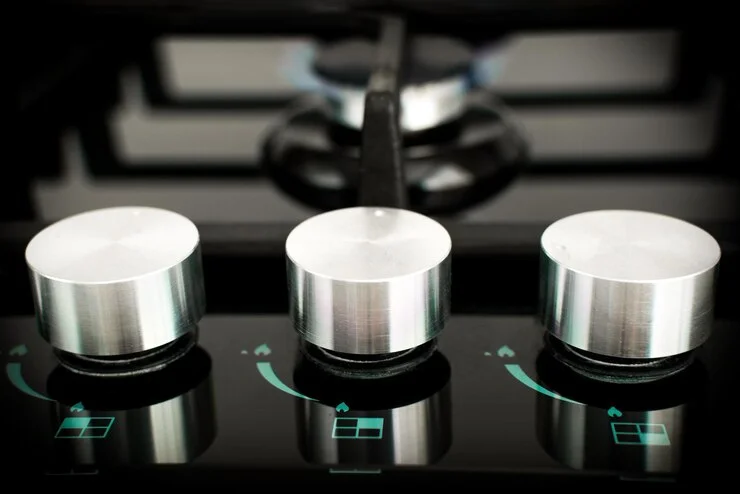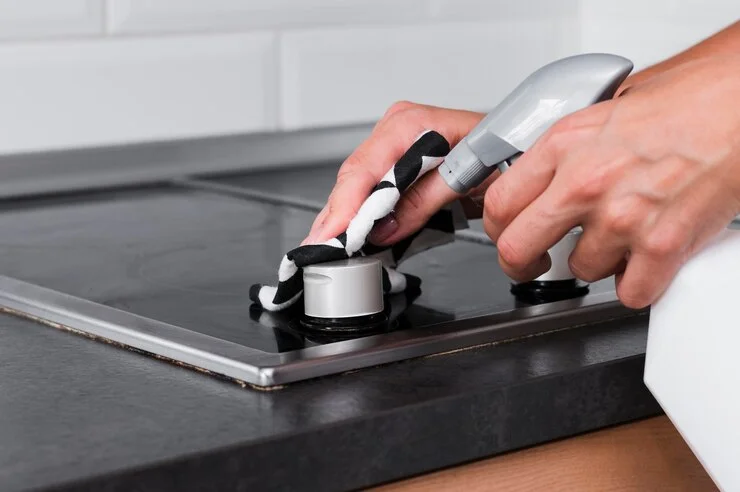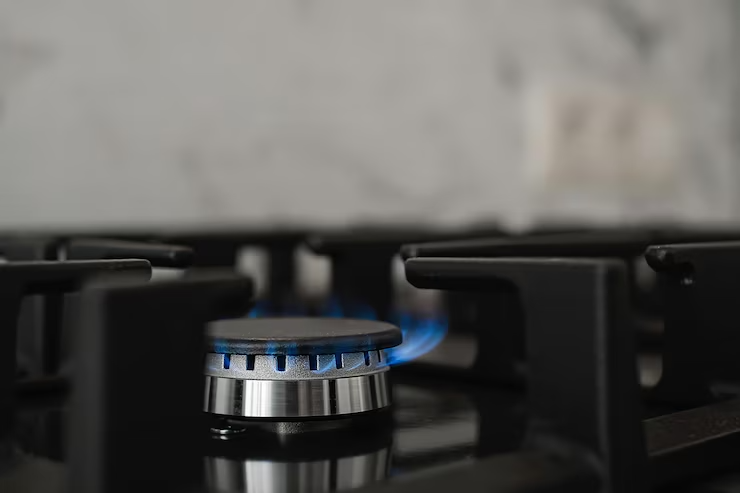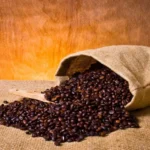Gas stove liners are thin, protective sheets placed under burners on a gas stove. They catch food spills, grease, and other messes while cooking. This helps prevent stains from sticking to the stove surface, making cleanup much easier.
Using stove liners keeps the kitchen cleaner and saves time in scrubbing hard-to-remove stains. They protect the stove from daily wear, which means it can stay in good condition longer. Plus, they’re easy to remove, wash, and reuse, making them a convenient solution for busy kitchens.
Understanding the Gas Stove Liners
Gas stove liners are protective sheets that fit around the burners on a gas stove. Their main purpose is to catch spills, crumbs, and grease during cooking. This helps keep the stove surface clean and free from sticky messes.
These liners are often made from heat-resistant materials like silicone or Teflon. Silicone liners are flexible and easy to wash, while Teflon ones are known for their non-stick surface. Both types can withstand high temperatures, making them safe for use on most gas stoves.
By catching spills, gas stove liners prevent food particles from sticking and burning onto the stove. This saves time and effort, as you don’t need to scrub the stove as often. Liners make it easy to keep the kitchen clean and organized every day.
Types of Gas Stove Liners
Gas stove liners come in two types: reusable and disposable. Reusable liners can be washed and used many times, saving money. Disposable liners, on the other hand, are thrown away after use, which can be convenient but adds to waste.
These liners are made from materials like aluminum foil, silicone, and Teflon-coated sheets. Aluminum foil liners are affordable but need regular replacement. Silicone liners are durable and easy to clean, while Teflon-coated liners offer a non-stick surface for easy food removal.
You can also choose between pre-cut and customizable liners. Pre-cut liners fit standard stove sizes, making them easy to use. Customizable liners, which can be cut to any shape, are better for stoves with unique burner layouts.
Benefits of Using Gas Stove Liners
Using gas stove liners offers many benefits that make cooking and cleaning easier. They help catch spills and prevent grease from sticking to the stove, which makes cleaning much faster. With a stove liner in place, you won’t have to scrub tough stains after every meal.

Liners also protect the stove’s surface from damage and stains, helping it last longer. They act as a barrier, reducing wear and tear over time. By using a liner, you can keep your stove looking new and avoid costly repairs or replacements.
Let’s look at the key benefits of using them in your kitchen.
- Easy Cleanup: Gas stove liners catch food spills and grease, making it quick and easy to wipe or wash messes away without scrubbing.
- Protection: Liners act as a shield, protecting the stove’s surface from stains, scratches, and other damage, helping it look new for longer.
- Cost-Effective: By reducing wear and tear, liners can extend the life of your stove, saving money on repairs or replacements.
- Heat-Resistant: Many stove liners are made from heat-resistant materials like silicone or Teflon, ensuring safe use even with high cooking temperatures.
- Environmentally Friendly Options: Reusable liners can be washed and used multiple times, which reduces waste and is more eco-friendly than disposable options.
How to Use Gas Stove Liners Effectively?
Installing Gas Stove Liners
- Ensure the stove is cool before placing the liner.
- Lay the liner flat on the stove, fitting it around the burners.
- Avoid blocking any gas vents or open flames for safety.
Maintaining and Cleaning Reusable Liners
- Remove the liner after cooking and wash it with warm, soapy water.
- Make sure the liner is completely dry before placing it back on the stove.
- Clean the liner regularly to keep it in good condition.
Safety Tips
- Always keep the liner away from open flames to avoid fire hazards.
- Do not let the liner touch the burners directly while cooking.
- Follow these safety steps to ensure a safe cooking experience.
Choosing the Right Gas Stove Liner for Your Kitchen
What to Consider When Buying Gas Stove Liners
When picking a gas stove liner, think about the material it’s made from. Some liners are made of aluminum foil, while others are silicone, offering different heat resistances. Make sure to choose a durable liner that can handle high temperatures without melting.
Size is also crucial for a good fit. Measure your stove before buying to ensure the liner covers the surface properly. A well-fitting liner will protect your stove effectively and won’t interfere with burners.
Compatibility with Stove Type
Different stove types may need specific liners to fit well. For example, some stoves have unique burner arrangements that need flexible liners. Check if the liner is suitable for gas or electric stoves before purchasing to avoid issues.
Choosing a compatible liner helps in easy placement and prevents accidents. A liner made for your stove type will also stay in place without slipping.
Price Comparison and Features to Look For
| Feature | What to Look For |
| Heat Resistance | Choose a liner that withstands high temperatures without warping or melting. |
| Ease of Cleaning | Look for liners that are dishwasher-safe for easier maintenance. |
| Popular Brands | Consider brands like Linda’s Essentials, YRYM HT, or Stock Your Home. |
Common Mistakes to Avoid with Gas Stove Liners
One common mistake is placing liners too close to the flame. This can cause the liner to burn or melt, which is dangerous. Always leave space around the burner for proper heat flow and safety.
Another mistake is covering gas vents with the liner, which blocks airflow. Blocked vents prevent your stove from working correctly and can be a fire hazard. Ensure your liner doesn’t obstruct any vents to keep your stove safe.
Lastly, using the wrong liner material can also be risky. Some materials, like thin foil, may not handle high temperatures well. Choose a heat-resistant liner to avoid melting and make cooking safer.
Tips for a Cleaner Kitchen

- Wipe the Stove after Each Use
Clean up any spills or splashes right after cooking to keep the stove spotless. - Use Baking Soda for Stubborn Stains
Sprinkle baking soda on tough stains, add a little water, and let it sit before scrubbing. - Try Vinegar as a Natural Cleaner
Spray a mix of vinegar and water on greasy spots, then wipe with a cloth for a shiny finish. - Use a Soft Scrub Pad
Avoid scratching the stove by using a soft pad instead of a harsh scrubber. - Consider Grease-Removing Products
Choose kitchen cleaners labeled “grease remover” for quick and easy cleaning of oily spots.
Bottom Lines
Using gas stove liners makes cleaning much easier and keeps your kitchen looking neat. They help protect your stove from spills, stains, and burnt-on food. With a liner in place, you spend less time scrubbing and more time enjoying your meals.
Gas stove liners are a great choice for a quicker, simpler kitchen cleanup. They’re easy to use and save you effort every day. Try gas stove liners and see the difference in your kitchen today!
Frequently Asked Questions (FAQs)
Q1. Does a gas stove need a flue liner?
Most gas stoves do not need a flue liner, as they vent through the room. Flue liners are mainly used with wood stoves or chimneys. Always check with a professional if unsure.
Q2. What are burner liners for?
Burner liners catch spills and crumbs, helping keep your stove clean. They protect the area around the burners from stains. Using burner liners saves time on cleaning.
Q3. How do you seal a gas stove line?
Sealing a gas line requires using a special sealant called pipe thread compound. This compound prevents gas leaks in the line. It’s best to have a professional do this for safety.
Q4. What are stove liners made of?
Stove liners are usually made of heat-resistant materials like aluminum or silicone. These materials can handle high temperatures safely. Always choose liners labeled as “heat-safe.”
Q5. Are burner liners safe?
Yes, burner liners are safe when used correctly and kept away from direct flames. Make sure they fit well and don’t cover vents. This helps prevent fire hazards.
Q6. How do I protect my gas line?
Keep your gas line free from heavy objects or sharp impacts to avoid damage. You can also cover it with a protective sleeve. Regular inspections by a professional help keep it safe.







